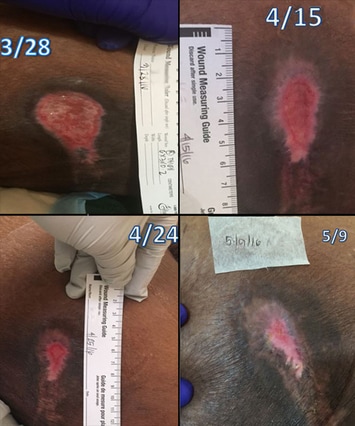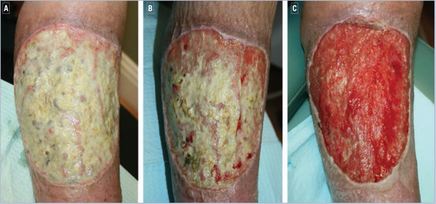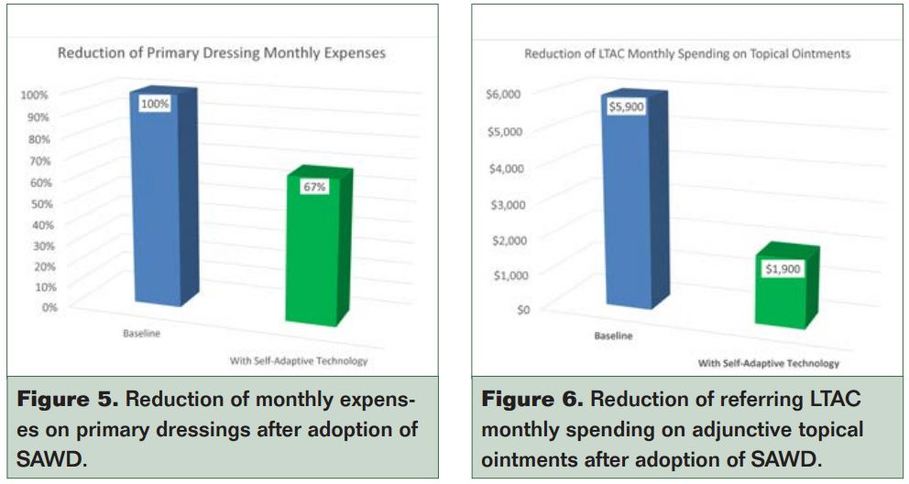ENLUXTRA BOOSTS PROFITS
FOR CARE PROVIDERS
IN ALL SETTINGS
Enluxtra Economics in Home Health:
|
Case: Pressure injury posterior thigh
Female, age 84 Non-ambulatory, wheelchair-bound for mobility. Co-morbidities: diabetes, atrial fibrillation, hypertension, dyslipidemia. Cause of wound: wheel chair bar located near the posterior thigh area. Healed in 6 weeks: 11 visits, 10 Enluxtra Dressings. 10 dressings: total cost $57.00
11 RN visits ($50 per visit): total cost $550 Reimbursement: $1500 |
In the video: agency manager and nurses: "savings, better clinical results, pain reduction"
The Highest Absorption Ever
Enluxtra dressings are able to absorb, lock-in and keep away from the wound massive amount of exudate. And you may STACK two or even more dressings to achieve virtually any desirable absorption, even comparable with NPWT canister.
And do not worry! Smart Enluxtra features will protect the wound from BOTH maceration and desiccation.
And do not worry! Smart Enluxtra features will protect the wound from BOTH maceration and desiccation.
Fast, Inexpensive, Painless and Easy Slough Removal
without use of expensive enzymatic agents
click to learn more...
|
Wounds 2015;27(8):229-235 Volume 27 - Issue 8 - August 2015: EVIDENCE OF INTENSIVE AUTOLYTIC DEBRIDEMENT WITH A SELF-ADAPTIVE WOUND DRESSING
Alexander M. Reyzelman, DPM and Mher Vartivarian, DPM |
Savings for Clinics
Study finds self-adapting dressing significantly reduces cost of care while providing better clinical outcomes and simplifying wound-care procedures.
- Reduced number of dressings needed
- Reduced dressing change frequency
- Reduced need for expensive topicals and enzymatics
- Reduced inventory cost by up to 30%
- Simplified protocol and training
- Simplified documentation
- Better clinical outcomes
Clinical Research Coordinator: "cost savings for clinic and patients"
Ultimate Standardization of First-Line Wound Dressings to a Single Type
COST REDUCTION AND FINANCIAL RESULTS
SAWDs are in the mid-range of current advanced wound dressing prices. They are generally more expensive than simple foam dressings, but significantly less costly than advanced foam dressings and silver-containing, collagen, hydroconductive, and other products.
The moderate price of SAWDs and their nearly 100% utilization led to reduction of total monthly spending on primary wound dressings upwards of 30% during the standardization study at the clinic compared to
baseline spending before the study (Figure 5). This spending reduction is estimated to provide the clinic with more than $40,000 annual savings on primary dressings.
Additional cost savings come from the elimination of many adjunctive products and the simplification of training, documentation, and inventory management.
ADDITIONAL BENEFITS
Cost Saving to Referring Long-Term Acute Care (LTAC) Facility. A referring LTAC facility that standardized to SAWD during the same study timeframe also benefited from significant cost savings. Patient outcomes met or exceeded facility expectations during this time. The managing pharmacist Dr. Abdel Bendamkila reported a reduction in topical pharmaceutical wound care product expenditures from an average of $5,900 per month to
$1,900 per month (Figure 6). These cost savings were due to a reduction in dressing change frequency from daily to 1-2 times weekly, as well as considerably reduced consumption of topical ointments, particularly autolytic debridement agents.
WHERE THE SAVINGS COME FROM
1. Labor Cost Reduction
2. Material Cost Reduction:
- Lower number of dressings needed for each wound
- 60% inventory reduction, 100% inventory utilization
- Less need for expensive supplementary products
- Straightforward staff training
- Better and more easily achievable treatment outcome both by patients or caregivers
- Fewer mistakes
REDUCED INVENTORY COST
Self-Adaptive dressing is able to replace a multitude of single-function dressings.
Self-Adaptive dressing provides an equal or better standard of care, and delivers it in the form of a single dressing with variable functionality. The design of Self-Adaptive dressing - which combines a non-adhering contact layer, an antimicrobial and strike-through barrier, and peri-wound skin protection - helps to prevent all the issues caused by traditional foam dressings, without the need for supplementary products.
Self-Adaptive dressing is able to replace a multitude of single-function dressings.
Self-Adaptive dressing provides an equal or better standard of care, and delivers it in the form of a single dressing with variable functionality. The design of Self-Adaptive dressing - which combines a non-adhering contact layer, an antimicrobial and strike-through barrier, and peri-wound skin protection - helps to prevent all the issues caused by traditional foam dressings, without the need for supplementary products.






